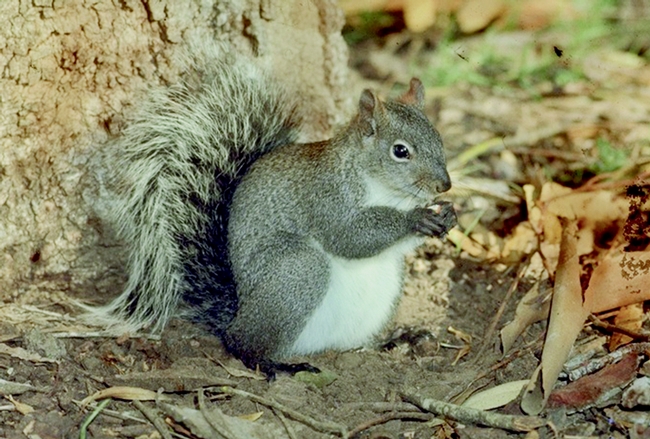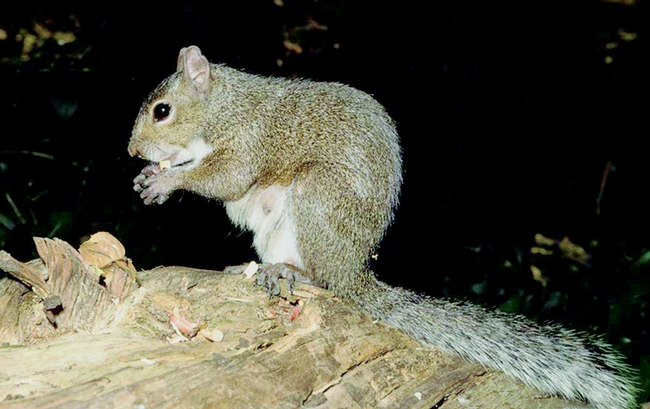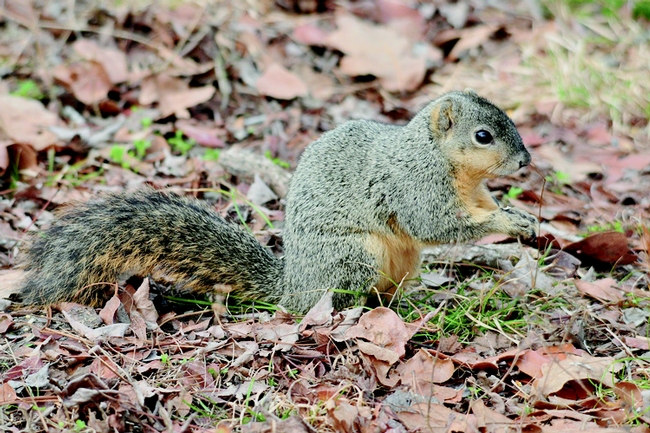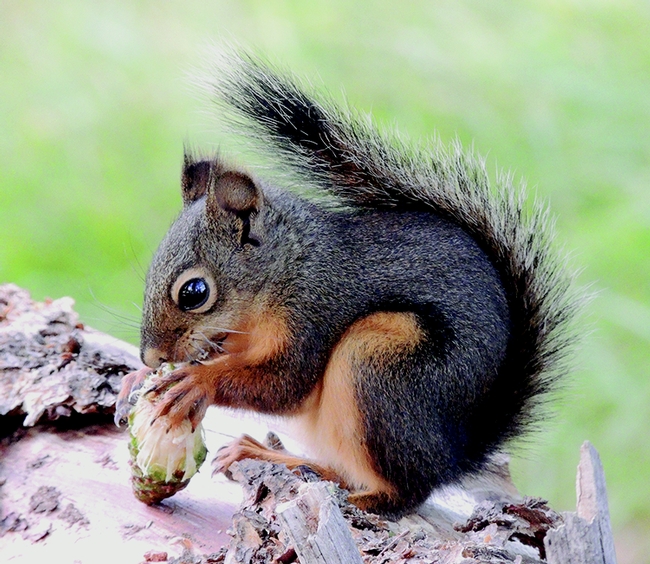[From the May 2015 issue of the UC IPM Green Bulletin]
Squirrels can be problem pests in many landscapes, gardens, and structures. California is home to several species of squirrels which can be divided into three groups: tree squirrels, ground squirrels, and flying squirrels. While ground squirrels and some species of tree squirrels can be pests, flying squirrels are very elusive and not often seen and not considered pests.
There are four species of tree squirrels in California (Table 1); two species are native and two are introduced from the eastern part of the United States. Although it is easy to distinguish the different squirrel groups from each other, often it is difficult to tell the difference between the species within the groups; this is especially true for the tree squirrels. Regulations regarding management of tree squirrels are complicated, so it is extremely important to be able to identify squirrels to species level.
Tree Squirrel Species




Management and Regulations
First and foremost, it is illegal to use poison baits in the management of ANY species of tree squirrel in California. Of the four tree squirrels, the eastern fox squirrel is considered to be the most serious pest to homes and gardens in urban and suburban environments. Fox squirrels that are found to be injuring growing crops or other property may be taken at any time or in any manner in accordance with the California Fish and Wildlife Code and Regulations (henceforth called “the Code”). Only eastern fox squirrels can be killed without a hunting license or permit.
Several types of kill traps are useful for fox squirrel removal, but they must be set in a way that will not accidentally trap nontarget animals. Live-catch cage traps are also available, but once caught the squirrel must be disposed of, presenting a problem for some people. Because releasing an eastern fox tree squirrel is illegal, live-catch traps are not recommended. For more information on trapping tree squirrels check out the UC IPM Pest Notes: Tree Squirrels.
Western gray squirrels are not generally considered as pests of home, gardens or agriculture but may be occasional forestry pests. In many counties in California, they can be taken in the general hunting season by those in possession of a valid hunting license from the California Department of Fish and Wildlife (CDFW). The hunting season occurs in the fall but can vary between zones (§307).
There is a bag limit of four squirrels per day. Hunting western gray squirrels is not permitted in several counties and zones in California (§307). In many areas of California, where it is legal to take squirrels during the general season, it is illegal to take them by archery and falconry. The areas where it is legal to use these methods can also be found in §307.
There are several methods authorized for the taking of western gray squirrels under the stipulations of the Code and county and city ordinances. Please consult section 311 of the Code for these legal methods which include a range of firearms and other options. Remember it is often illegal to discharge many types of firearms in cities, and even in unincorporated areas. Please contact your local sheriff for more information. Please see section 311 the Code, “Methods Authorized for Taking Resident Small Game” for more information on the use of firearms and bow and arrow.
CDFW has prohibited the use of lead projectiles in some firearms in the California condor range. Generally, when people shoot nongame animals they leave them behind and this can be hazardous for scavengers like the California condor. Currently, the use of lead ammunition is permitted for the taking of small game animals such as tree squirrels. However, bill AB 711 would instead require, as soon as is practical, but by no later than July 1, 2019, the use of nonlead ammunition for the taking of all wildlife, including game mammals, game birds, nongame birds, and nongame mammals, with any firearm. Given the associated risks to scavenging wildlife, tree squirrels should be shot with non-lead ammunition. Squirrels shot with lead ammunition should be removed and disposed of in a manner that will not leave them open to scavenging wildlife.
The above regulations also cover all the other species of tree squirrels in California. Eastern fox squirrels, also covered under this legislation, may be trapped by any legal means if they are shown to be causing damage to crops or property. If land or property is being damaged or destroyed, or is in danger of being damaged or destroyed by a western gray squirrel or an eastern gray squirrel, then the owner or tenant of that land or property may apply to the CDFW for a depredation permit which will allow for the killing of the squirrel. The CDFW will designate the type of trap to be used to insure the most humane method is used to trap gray squirrels. Under the terms of the depredation permit, it may be required to release trapped squirrels in parks or other nonagricultural areas. It is not permitted to use any type of poisons to take a western gray squirrel, even when in the possession of a depredation permit.
Remember, any trapper for hire must possess a valid trapping license from the CDFW when trapping any squirrel species for profitable gains. A valid hunting license is required for sport hunting of tree squirrels also. However, if a landowner legally shoots a depredating eastern fox squirrel outside of the hunting season, a hunting license would not be required.
While uncommon occurrences, tree squirrels can be associated with pathogens that can potentially be harmful to humans. Under the Code, tree squirrels that are associated with dangerous disease outbreaks may be taken by appointed organizations. See section 4011 for a list of organizations to contact in such a case.
“Breaking” the Fish and Wildlife Code for Tree Squirrel Management
The CDFW's Fish and Game Code is certainly very difficult to navigate. Here are a few things to remember that will help you “break” through the code:
- Tree squirrels are considered as resident small game. When the Code refers to “tree squirrels” it means eastern and western gray squirrels, eastern fox squirrels, and the Douglas squirrel. Details of the hunting areas and season for tree squirrels can be found in chapter 2, §307. Look out for differences in zones, as well as counties, and for differences between general hunting and taking using falconry and bow and arrow.
- The regulations that govern take of tree squirrels can be found in section 311.
- In the Code, reference to “gray squirrels” means both eastern and western gray squirrels. It may seem unusual that the regulations for the management of a native and an invasive species are the same; but that is what the Code says, and it is important to follow it. Information on depredation permits for eastern and western gray squirrels can be found in section 4181.
For more information on tree squirrel management, consult the UC IPM Tree Squirrels Pest Note and the California Department of Fish and Wildlife Code.
Attached Images:
